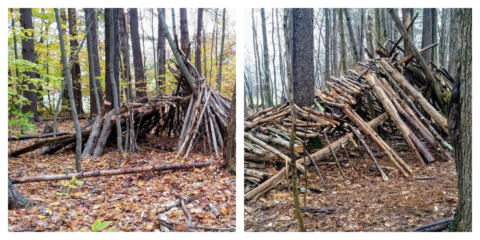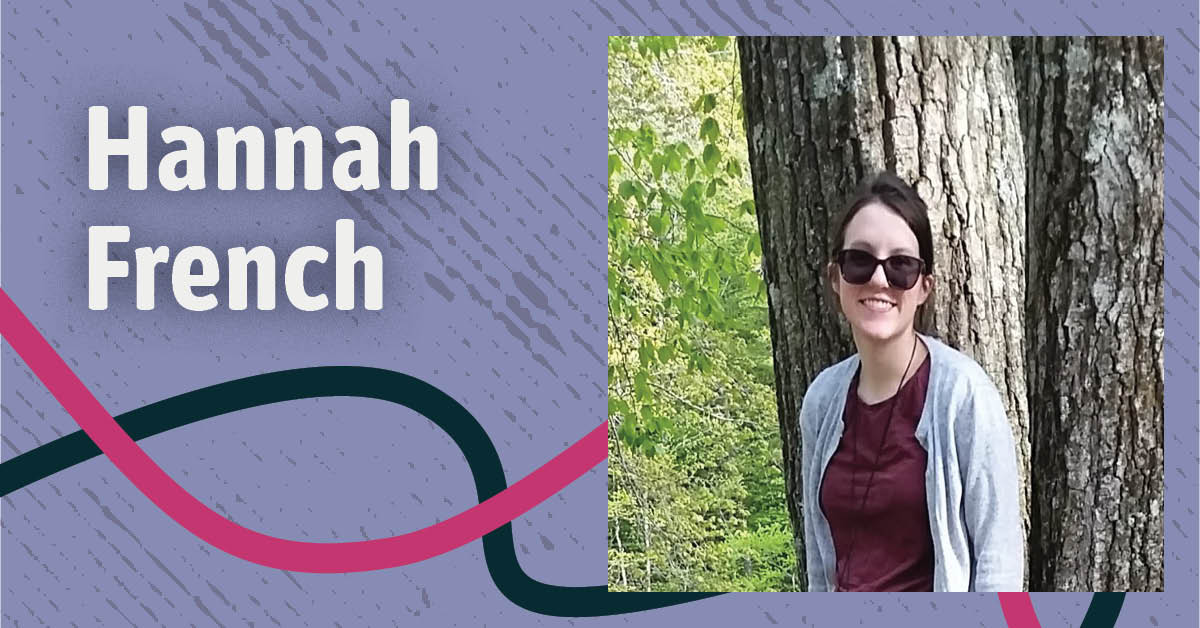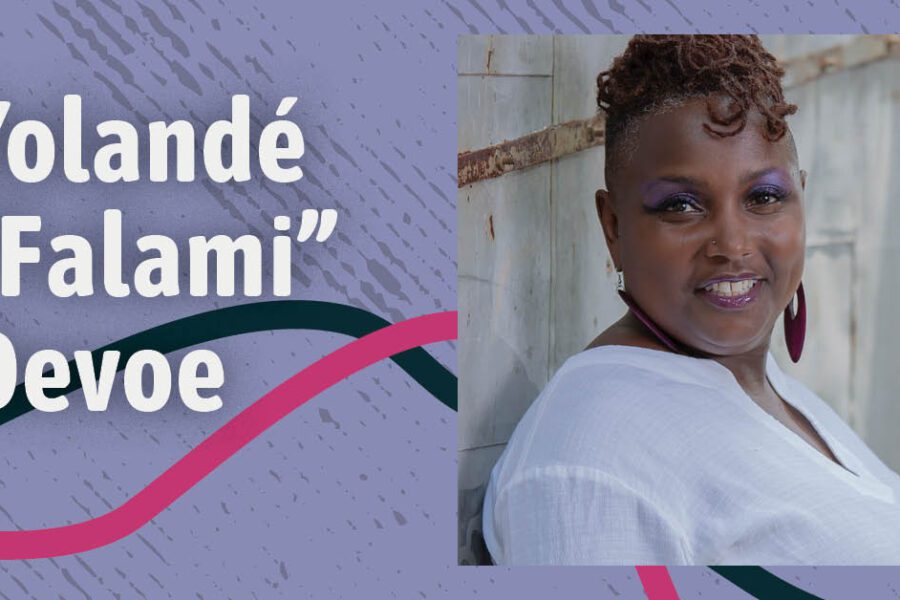For Hannah French’s third- and fourth-grade students, their classroom during the pandemic has much better air circulation than before. And it’s also a lot greener. And sunnier.
This is because every day they meet not in a traditional classroom but instead in the woods adjacent to Rowe Elementary School, where an array of stumps serve as seats and desks. Students bring their own hammocks for individual work—and so they can stay dry on those days when there’s snow on the ground. There are tarp canopies for use during inclement weather and uncleared areas of forest for climbing and adventuring during free play.
This is the forest classroom, an outdoor space in which children can learn, exposed to the wonders of nature and released from the constraints of a traditional classroom’s walls and fluorescent lighting. Teaching class outdoors every day has long been a dream and goal for advocates of outdoor learning. But for French, she never thought that she would accomplish it so quickly.
Hannah French holds a Master of Education in Elementary Education from Antioch University New England, and it was during her study for this degree that she began studying the integrated learning model and ideas of forest school and outdoor education. She graduated in 2017 and is currently in her third year of teaching a mixed-age third and fourth-grade class at Rowe Elementary School in northeastern Massachusetts.

From the beginning of teaching this class, French, along with her co-teacher, introduced outdoor learning experiences. The first was what they called “Forest Fridays”: a weekly opportunity to get out of the classroom and into the woods for free play, group challenges, and place-based projects. The forays into the outdoors were enormously successful. Students loved it, and the teachers saw incredible social and educational benefits.
“We’ve listened to students hone their communication skills as they build forts and play on log see-saws,” French says. And it’s not just interpersonal skills that thrive out of doors. “We’ve witnessed high engagement in core subjects when we design activities that include movement and incorporate elements of the landscape,” she explains.
The plan was to continue building outside time into the schedule, hopefully, more with each passing year. Then the pandemic hit. At first, all teaching had to be remote—the antithesis of outdoor education. Then at the beginning of the 2020-21 school year, the district called for full-time in-person learning. However, in order to comply with safety requirements, there would need to be strict social distancing between students.
“We knew what indoor learning would look like: rows of distanced desks, little room to move around, and so on,” French says. This would be tough on both the students and the teachers, and French didn’t think it would be sustainable at all for kids at that age level. So she proposed expanding the use of outdoor classrooms instead. “We tried to reframe the situation,” she explains, “imagining it as a catapult towards our ultimate ideal of everyday outdoor learning.”
The school agreed to try it, and for the last half-year, French’s class has been meeting outside, every day, rain or shine. And it’s been a wonderful success, so far.
“In the forest, we’ve watched friendship dynamics strengthen and evolve,” French says. The growth she’s seen is spread among many different learning skills: “We’ve noticed confidence increase as students take risks and participate in group challenge initiatives. We’ve observed newly-learned ideas transfer into imaginary play completely unprompted by adults.”
A Winding Path to Elementary Education
 Like many Antioch students, French’s path to her chosen career wasn’t linear. As an undergrad at the University of Massachusetts, Amherst, she majored in environmental sciences and minored in biology, yet she couldn’t see herself working as a researcher in a lab for the rest of her career. Among the jobs that she took as a student were a work-study position teaching traditional crafts on campus and a job at an environmental education center. These experiences helped her realize that her passion was in education.
Like many Antioch students, French’s path to her chosen career wasn’t linear. As an undergrad at the University of Massachusetts, Amherst, she majored in environmental sciences and minored in biology, yet she couldn’t see herself working as a researcher in a lab for the rest of her career. Among the jobs that she took as a student were a work-study position teaching traditional crafts on campus and a job at an environmental education center. These experiences helped her realize that her passion was in education.
When she was choosing a graduate school where she could also get her teaching credential, Antioch was a natural fit. I fulfilled both her educational licensure requirements and a growing interest in place-based education.
The Elementary Education program helped French to build a bridge between her scientific studies and her teaching aspirations. At Antioch, she was able to focus on place-based education and simultaneously learn about developmentally appropriate, student-centered teaching methods.
“No other program felt so perfectly aligned with my desires to include the natural world in my teaching while honoring the sense of wonder I had witnessed in the children I worked with,” French says.
And the education led directly to the work that she wanted to be doing. “After I completed the program,” says French, “I was able to become a certified elementary educator, and not too long after that I was able to secure a teaching position that I love. There’s no question that the training that I received in the Integrated Learning Program set me up for success.”
Refining the Outdoor Classroom
The plan moving forward at Rowe Elementary is to continue to improve the outdoor classroom space, refine outdoor teaching methods, and keep working to get the class outside five days a week, year-round!
Students currently have a regular nature journaling practice which includes a student-led sharing of writing. French hopes to develop this exercise so that it includes nature-themed mentor texts, sentence study, and foundational writing skills. Another goal is to integrate equitable, trauma-informed practices and anti-biased, anti-racist practices into the daily routine.
As she thinks about the future of her work educating students outside, she remembers a specific project her students decided to undertake—a project that captures the way learning outside can build skills and cultivate resilience.
 The story starts last fall when a group of students decided to build a fort that would be large enough inside for physical distancing. “Day after day, they hauled logs and sticks over to their chosen location and added them to their growing structure,” explains French. “Finally, a spacious, albeit a bit unsteady, structure resulted.” It was a big success, and the students enjoying using the fort all winter.
The story starts last fall when a group of students decided to build a fort that would be large enough inside for physical distancing. “Day after day, they hauled logs and sticks over to their chosen location and added them to their growing structure,” explains French. “Finally, a spacious, albeit a bit unsteady, structure resulted.” It was a big success, and the students enjoying using the fort all winter.
This spring, however, a small tragedy struck: “after lots of snow and wind, the fort collapsed!” But the students were resilient, says French. “With little frustration or worry, the same group of students systematically broke down what remained. All of the sticks and logs were removed and sorted into piles based on size. Then the group rebuilt, this time a bigger and better fort.”
To French, this story captures something about the possibilities of outdoor education. As she says, “It is clear that through their play and their work these kids have learned a great deal about building process and structure as well as planning and communication.”
Learn more about the Rowe Elementary Forest Fridays program here. Hannah French is a participant in the Inside-Outside Network for Nature-Based Educators, an offshoot of Antioch’s nature-based education program, and has been a presenter at Antioch’s In Bloom conference.






